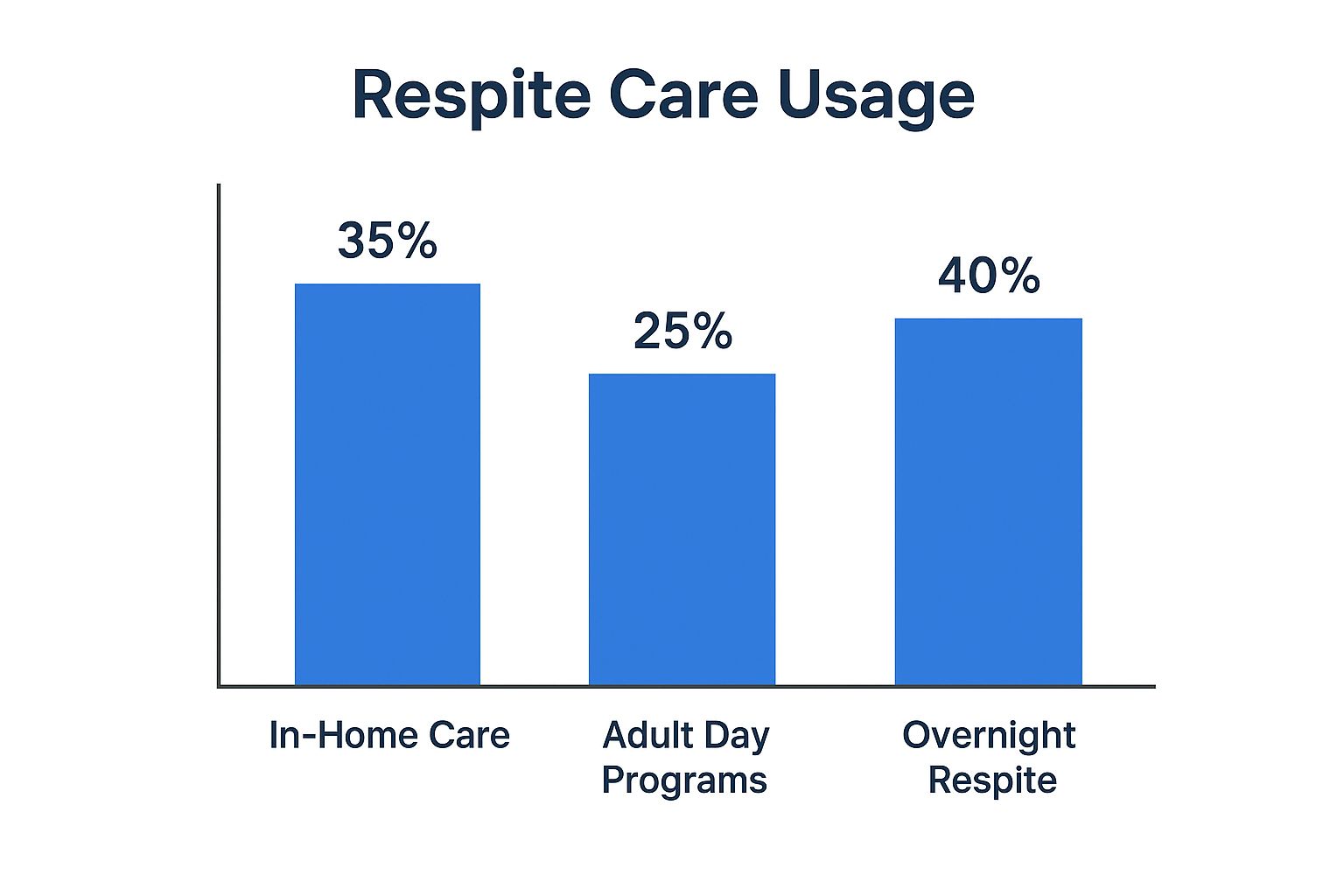The Real Impact of Respite Care for Caregivers
Caregiving is a deeply personal journey, filled with the profound rewards of supporting a loved one. However, it also presents significant demands on the caregiver. Prioritizing your own well-being isn't selfish—it's essential. This section explores the tangible benefits of respite care for caregivers.
Why Respite Care Matters
Respite care provides temporary relief for caregivers, allowing them to take much-needed breaks from their responsibilities. These breaks can range from a few hours of in-home assistance to longer stays in adult day programs or specialized facilities. These breaks are not luxuries, but crucial components of a sustainable care plan. Respite care enables caregivers to recharge, reducing stress and preventing burnout. This ultimately allows them to continue providing the best possible care for their loved ones. You might be interested in: Our sitemap for more articles
The Transformative Effects of Respite
The advantages of respite care go beyond simple stress reduction. Regular breaks can significantly improve a caregiver's physical and emotional health. This can lead to lower rates of chronic illness and a decrease in anxiety and depression. Respite care also allows caregivers to reconnect with personal interests and maintain a sense of identity outside of their caregiving role. This can lead to a renewed sense of purpose and overall well-being.
The impact of respite care on caregivers is noteworthy. As of 2023, 75% of unpaid family caregivers in the U.S. reported needing in-home respite care services from paid professionals. Over 50% emphasized the need for structured breaks like adult day care. This highlights the growing recognition of caregiver burnout, particularly among the estimated 43.5 million Americans providing unpaid care. Find more detailed statistics here. These figures underscore the importance of respite care in supporting this invaluable group.
Respite Care Benefits for Care Recipients
Respite care also has a positive impact on the care recipient. A refreshed and recharged caregiver is better equipped to provide patient, attentive, and compassionate care. Respite care can also offer the care recipient opportunities for social interaction and engagement in stimulating activities, enriching their lives.
Building a Sustainable Caregiving Future
Using respite care is not a sign of weakness; it shows a caregiver's commitment to both their loved one and themselves. By prioritizing their well-being, caregivers create a sustainable journey that benefits everyone. This means building a future where caregiving is both rewarding and manageable.
Recognizing When You Desperately Need a Break

The demands of caregiving can quickly lead to burnout, a state of physical, emotional, and mental exhaustion. Recognizing the signs is crucial for both the caregiver and the person receiving care. This section explores those indicators and highlights the importance of respite care.
Identifying the Red Flags
Burnout manifests in many ways. It's important to be aware of the common physical and emotional symptoms. Persistent exhaustion, even after sleeping, is a key indicator.
Changes in appetite, increased irritability, and difficulty concentrating can also signal you're approaching your limit. Everyday tasks may feel overwhelming, and you might withdraw from social interactions.
Emotional Toll of Caregiving
Beyond the physical symptoms, caregiver burnout takes a significant emotional toll. This can manifest as anxiety, hopelessness, or even resentment.
These feelings impact not only your well-being but also the quality of care you provide. Frustration and impatience can strain your relationship with your loved one. Caregivers often experience burnout, which can be alleviated by respite care. Sometimes you need strategies for actively recovering from burnout. This article offers steps for recognizing burnout, addressing its root causes, and implementing self-care practices.
The Impact on Care
When a caregiver is burned out, the quality of care they provide can decrease. Tasks once easily managed become difficult. The care recipient may also sense the caregiver's emotional strain.
This can lead to a decline in the care recipient's well-being, creating a difficult cycle where both individuals struggle.
Recognizing Your Limits: A Self-Assessment
Honestly assessing your situation and acknowledging when you need help is essential. This means recognizing your limits and prioritizing your own well-being. A simple self-assessment can help determine if you’re experiencing burnout.
- Are you experiencing persistent fatigue or exhaustion?
- Have your sleeping or eating habits changed significantly?
- Do you feel increasingly irritable or withdrawn?
- Are you finding it difficult to concentrate or make decisions?
- Are you experiencing feelings of anxiety or depression?
If you answer yes to several of these questions, consider respite care. Recognizing your need for support isn’t a weakness. It's a vital step toward ensuring both your well-being and that of your loved one. Taking a break allows you to return to your caregiving role refreshed and better equipped to provide the best possible care.
Finding Your Perfect Respite Care Match

Finding the right respite care solution can feel overwhelming, but it's crucial for both your loved one's well-being and your own peace of mind. Not all respite care is created equal. The key is to find the type that best addresses your unique circumstances. This means considering your loved one's needs, your own limitations, and the spectrum of available options.
Exploring Respite Care Options
Respite care offers a variety of services designed to provide temporary relief for caregivers. These services are flexible and can be delivered in different settings, accommodating diverse needs. This could mean care in your home, at a specialized facility, or as part of a community program.
-
In-Home Respite Care: With this option, professional caregivers come to your home. They provide personalized attention, allowing your loved one to stay in familiar surroundings. Services range from companionship and meal preparation to help with personal care needs.
-
Adult Day Programs: These programs offer structured activities, socialization, and meals in a safe and supervised environment. Adult day programs can provide valuable stimulation and engagement for your loved one, giving you time to attend to personal matters or simply recharge.
-
Residential Respite Care: Some assisted living facilities and nursing homes offer short-term respite stays. This option offers a structured environment with 24/7 support, ideal for longer breaks or unexpected situations.
-
Hybrid Models: Innovative hybrid options combine traditional support with virtual care solutions. This might include remote monitoring coupled with in-person visits, providing increased flexibility and peace of mind.
Matching Needs with Services
Choosing the best respite care option depends on individual circumstances. It’s essential to understand both your loved one's care needs and your own capacity. For instance, if your loved one requires complex medical care, in-home nursing might be necessary. If the primary need is companionship and social interaction, an adult day program could be a better fit. You can explore job listings at Caring Hands Senior Services for further options.
To help you compare different options, we've compiled a table summarizing key features and considerations:
Comparison of Respite Care Options
| Respite Type | Services Provided | Typical Cost Range | Best For | Availability |
|---|---|---|---|---|
| In-Home Care | Personal care, companionship, meal preparation, medication reminders | $25-$50/hour | Individuals preferring to stay at home, varying needs | Widely available |
| Adult Day Program | Supervised activities, socialization, meals, some medical care | $75-$150/day | Individuals needing social interaction, moderate care | Varies by location |
| Residential Respite Care | 24/7 care, meals, activities, medication management | $150-$300/day | Individuals needing short-term intensive care, caregiver breaks | Limited availability |
| Hybrid Care | Remote monitoring, in-person visits, customized care plans | Varies depending on services | Individuals seeking flexible and technologically advanced care | Growing availability |
This table offers a quick overview of various respite care services, their typical costs, and ideal situations for use. Remember to research specific providers in your area for accurate pricing and availability.
Cost and Funding
Respite care costs can vary depending on the service type, duration, and provider. While it's an added expense, financial assistance may be available. Explore options like long-term care insurance, veterans' benefits, and other funding sources.
The data chart below illustrates the average weekly cost of various respite care options.
| Respite Care Type | Average Weekly Cost |
|---|---|
| In-Home Care (4 hours/day) | $500 – $1200 |
| Adult Day Program (5 days/week) | $300 – $700 |
| Residential Respite Care (short-term) | $1500 – $4000 |
As the chart shows, residential respite care typically has the highest cost, while adult day programs are generally the most affordable. In-home care costs fall in between, varying based on the hours of service required.
Demand for companionship services, a core component of respite care, has increased by 22% in the last five years. This rise reflects growing senior isolation and caregiver strain. In the U.S., 53 million adults provide non-medical care, with 51% of recipients living independently. As life expectancy increases and long-term care needs grow, respite care solutions are becoming increasingly vital for caregivers. More information on these trends can be found in home care industry statistics.
Quality and Safety: Choosing the Right Provider
When selecting a respite care provider, prioritize quality and safety. Verify licenses and certifications, check references, and conduct thorough interviews. Ask about staff training, background checks, and emergency protocols. This due diligence ensures your loved one receives the best possible care in a safe and supportive environment.
How Respite Care Transforms Caregiver Wellbeing

Respite care offers caregivers more than a temporary break. It's a vital opportunity to restore their physical and emotional well-being. This revitalization significantly improves the overall caregiving experience. This section explores the positive impact of regular respite on caregiver health and the ripple effect on the care recipient.
The Restorative Power of Breaks
The constant demands of caregiving can impact a caregiver's health. Regular breaks, provided by respite care, allow caregivers to address their own needs. This includes getting enough sleep, eating nutritious meals, and engaging in physical activity.
These seemingly simple acts profoundly impact physical and mental health. For example, studies show a link between chronic stress and an increased risk of cardiovascular disease, weakened immune function, and mental health challenges.
Respite care helps mitigate these risks by providing opportunities for stress reduction and promoting wellness. This means caregivers who use respite care are better prepared for the challenges of their role.
Emotional Renewal and Reduced Burnout
Respite care offers more than physical restoration; it provides essential emotional renewal. The emotional demands of caregiving can be overwhelming, leading to anxiety, depression, and burnout. Regular breaks help caregivers manage these emotions and prevent burnout.
Respite care also enables caregivers to reconnect with personal interests and social connections. This is crucial for maintaining a sense of identity outside of caregiving. When caregivers nurture themselves, they return to their responsibilities with renewed energy and focus.
Enhanced Caregiving Through Self-Care
The benefits of respite care extend beyond the individual caregiver, directly impacting the quality of care provided. A well-rested, emotionally balanced caregiver provides more patient, attentive, and compassionate care. This fosters a more positive and supportive relationship between caregiver and recipient.
Respite care can also provide the care recipient with opportunities for social interaction and enriching activities. This creates a positive feedback loop where both the caregiver and care recipient benefit. Ultimately, respite care is an investment in the well-being of both individuals.
Real-World Examples of Transformation
The power of respite care is evident in countless caregiver experiences. Many report a significant decrease in stress and an increase in their overall sense of well-being after using respite services.
One caregiver shared how regular breaks allowed her to address her own health concerns, resulting in improved sleep and increased energy. Another described how respite care enabled him to reconnect with hobbies, leading to a renewed sense of purpose. These examples demonstrate how respite care empowers caregivers to prioritize their well-being, leading to a more fulfilling caregiving journey.
Breaking Through Barriers to Getting the Help You Need
Finding respite care can often feel overwhelming, but accessing these vital services is crucial for sustainable caregiving. This section addresses common obstacles that prevent caregivers from getting the support they need, offering practical solutions to overcome each challenge.
Financial Constraints: Unveiling Available Resources
Cost is often the most significant barrier to respite care. Many caregivers believe they simply can't afford it. However, several underutilized resources can help alleviate this financial burden.
-
Explore Medicare and Medicaid: While Medicare doesn't typically cover long-term respite care, it may cover short-term skilled care after a hospital stay. Medicaid, on the other hand, often provides respite care coverage for eligible individuals. Understanding these programs is the first step to accessing potential benefits.
-
Veteran's Benefits: Veterans and their spouses may qualify for respite care assistance through the Department of Veterans Affairs. This often-overlooked benefit can provide significant financial relief.
-
Nonprofit Organizations: Many nonprofit groups offer financial assistance for respite care. Local community organizations and disease-specific foundations may have grant programs or subsidies to help cover costs.
Consider exploring flexible payment options with respite care providers. Some agencies offer sliding scales or payment plans to make their services more accessible.
Guilt and Resistance: Communicating the Need for Respite
Many caregivers struggle with guilt about taking breaks. They may feel they should manage everything independently. This internal barrier can be as challenging as financial limitations. For family members or the care recipient who may resist outside help, open communication is essential.
-
Explain the Benefits: Clearly explain how respite care benefits both the caregiver and the care recipient. A well-rested caregiver can provide higher-quality care.
-
Start Small: Begin with short respite periods to acclimate everyone to the process. This allows everyone to adjust to the idea of temporary outside assistance.
-
Involve Family Members: Include family members in discussions about respite care. Shared responsibility can lessen the burden on a single caregiver. You might be interested in: Our category sitemap for more articles on managing family dynamics in caregiving.
Overcoming guilt involves recognizing that seeking help demonstrates strength, not weakness. It's about prioritizing long-term, sustainable care for everyone involved.
Finding Trustworthy Providers: Vetting for Peace of Mind
Finding trustworthy respite care providers can feel daunting. Entrusting a loved one's care to someone new requires careful thought and research. This involves thoroughly vetting potential providers.
-
Check Credentials: Verify licenses, certifications, and insurance coverage. Look for providers who follow industry best practices and uphold high standards of care.
-
Seek Recommendations: Ask friends, family, doctors, or social workers for recommendations. Personal referrals can offer valuable insights.
-
Conduct Interviews: Interview potential providers to assess their experience, care approach, and communication style. Ask specific questions about training, background checks, and emergency procedures. Direct interaction is key to evaluating compatibility with your loved one's needs.
Finding the right respite care provider requires time and effort, but the peace of mind it provides is invaluable. Proactive steps ensure you can confidently find a trustworthy and supportive provider to meet your needs. This allows you to provide optimal care for your loved one while safeguarding your well-being.
The Evolving Landscape of Respite Support

The world of respite care is constantly changing, adapting to the evolving needs of caregivers and their loved ones. This shift is fueled by advancements in technology, changing demographics, and a growing recognition of the critical importance of caregiver well-being. Let's explore how respite care is transforming and what these changes mean for families.
Technology's Growing Role in Respite Care
Technology is playing an increasingly vital role in shaping the future of respite care. Remote monitoring systems, for instance, empower caregivers to check in on their loved ones from afar, providing peace of mind during short breaks. This allows caregivers to attend appointments, run errands, or simply unwind, knowing their loved one is safe and secure.
Telehealth services are also expanding access to medical professionals. These services offer virtual check-ins, medication management, and even therapy sessions, reducing the need for frequent trips to the doctor’s office. This saves caregivers valuable time and energy, especially for those caring for individuals with mobility challenges or living in rural communities.
Integrating Caregiver Support into Healthcare Systems
Traditionally, caregiver support has existed largely outside of mainstream healthcare. However, this is starting to shift. Healthcare systems are recognizing the essential role caregivers play and are beginning to integrate support services directly into their models of care.
This integration provides caregivers with direct access to resources and information through their loved one’s healthcare provider. Some hospitals, for example, now have dedicated caregiver support teams that offer education, counseling, and referrals to respite care services. This streamlined approach makes it easier for caregivers to access essential support.
Shifting Demographics and the Demand for Respite
As the population ages, the demand for respite care continues to grow. By 2025, innovations in respite care will likely focus on technology and wellness programs designed to alleviate caregiver burden. Home monitoring systems are expected to play a central role, enabling safer independent living for seniors and decreasing hands-on care hours.
Legislative and operational changes in long-term care, such as improved training and telehealth integration, seek to meet the growing needs of the aging population, particularly as Baby Boomers reach their 80s. Globally, the movement toward community-based respite care models reflects trends seen in the U.S., where 29% of caregivers live with their care recipients. This highlights the need for scalable solutions to support the mental and physical health of individuals within caregiving households. Learn more about home care predictions. Explore strategies to help caregivers avoid exhaustion and prioritize their own well-being: prevent burnout.
This increasing demand for respite care is also fueling innovation and creating new opportunities for caregivers to find the support they desperately need. It also emphasizes the need for affordable and accessible respite care choices, which means exploring different funding models, expanding community-based programs, and developing creative solutions to meet the expanding needs of caregivers. Ultimately, this trend reinforces the importance of advocating for policies that support caregivers and ensure access to these critical respite services.
The following table highlights some emerging technologies and their potential impact on respite care:
Emerging Respite Care Technologies
| Technology | Primary Function | Caregiver Benefit | Implementation Timeline | Potential Challenges |
|---|---|---|---|---|
| Remote Monitoring Systems | Track vital signs, activity levels, and location | Peace of mind, early detection of issues | Currently available, increasing adoption | Data privacy, cost, technical literacy |
| Telehealth Platforms | Virtual doctor visits, medication management, therapy | Reduced travel time, improved access to care | Rapidly expanding | Digital divide, reimbursement policies |
| Smart Home Technology | Automated lighting, reminders, safety alerts | Increased independence for care recipients, reduced caregiver burden | Growing integration | Cost, compatibility, user adoption |
| AI-Powered Care Assistants | Provide companionship, cognitive stimulation, and reminders | Reduced social isolation, cognitive support | Early stages of development | Ethical considerations, data security |
| Wearable Health Trackers | Monitor activity, sleep, and other health metrics | Data-driven insights into care recipient's health | Widely available | Accuracy of data, user comfort |
This table provides a snapshot of the exciting innovations occurring in the respite care space, offering potential benefits for both caregivers and care recipients. While challenges remain, the ongoing development and implementation of these technologies hold immense promise for enhancing the quality of life for families navigating the complexities of caregiving.
Building Your Personalized Respite Strategy
Caring for a loved one is a deeply rewarding experience, but it can also be demanding. Building a personalized respite strategy is essential for your long-term well-being as a caregiver. It's about moving from simply knowing about respite care to actively incorporating it into your life. This section will guide you through crafting a plan tailored to your unique needs.
Assessing Your Needs and Breaking Points
The first step is honestly evaluating both your loved one's care requirements and your own limitations. Consider the types of care they need, such as personal care, medical support, or companionship.
Then, reflect on your physical and emotional capacity. Identifying your breaking points—those times when you feel overwhelmed or exhausted—is crucial. For instance, if balancing household chores with caregiving becomes too much, incorporating chore services into your respite plan could be helpful.
Mapping Support Options
Once you understand your needs, explore the different respite care options. These can range from in-home care and adult day programs to short-term residential stays.
Also, consider your informal support network. Friends and family can often provide occasional assistance. The key is matching specific care needs with the right services. An adult day program might be perfect if your loved one primarily needs social interaction. If they require significant medical attention, in-home nursing care could be more appropriate.
Determining Frequency and Duration
The ideal frequency and duration of your respite breaks will depend on the intensity of your caregiving responsibilities and your available resources. A caregiver providing 24/7 care might need more frequent and longer breaks than someone offering intermittent support.
This could involve scheduling a few hours of in-home care weekly or a week-long residential stay every few months. Even short, regular breaks can significantly prevent burnout.
Introducing New Care Providers
Introducing new care providers requires thoughtful planning to minimize disruptions and foster trust. Open communication with your loved one is key. Involve them in the decision-making process whenever possible.
A detailed care plan ensures consistency between your care and that of other providers. This plan should outline your loved one's routines, preferences, medical needs, and any potential challenges. This helps new providers understand their specific needs and offer consistent, high-quality care.
Combining Formal and Informal Support
Maximize your resources by blending formal respite services with informal support from friends and family. You might use a formal in-home care service a few days a week and ask a family member to help on weekends.
This combined approach balances professional support with personal connections, making your respite strategy more sustainable in the long run.
Reassessing and Adjusting Your Plan
Caregiving needs change over time, so regularly reassessing your respite plan is vital. Stay flexible and adjust your strategy as needed. You might find that your initial respite frequency isn't enough. As your loved one's needs change, you might need to transition from in-home care to an adult day program. Regular evaluation ensures your respite plan remains effective and meets your evolving needs.
Are you feeling overwhelmed and needing support? Caring Hands Senior Services offers personalized respite care solutions for your unique situation. We provide compassionate, professional care, allowing you to take a break while ensuring your loved one receives the best possible support. Visit Caring Hands Senior Services today to learn more about how we can help you find the respite care you deserve.


